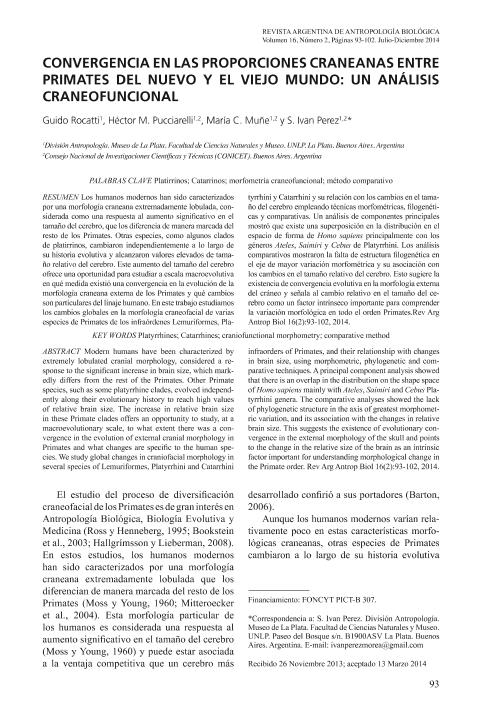Artículo
Los humanos modernos han sido caracterizados por una morfología craneana extremadamente lobulada, considerada como una respuesta al aumento significativo en el tamaño del cerebro, que los diferencia de manera marcada del resto de los Primates. Otras especies, como algunos clados de platirrinos, cambiaron independientemente a lo largo de su historia evolutiva y alcanzaron valores elevados de tamaño relativo del cerebro. Este aumento del tamaño del cerebro ofrece una oportunidad para estudiar a escala macroevolutiva en qué medida existió una convergencia en la evolución de la morfología craneana externa de los Primates y qué cambios son particulares del linaje humano. En este trabajo estudiamos los cambios globales en la morfología craneofacial de varias especies de Primates de los infraórdenes Lemuriformes, Platyrrhini y Catarrhini y su relación con los cambios en el tamaño del cerebro empleando técnicas morfométricas, filogenéticas y comparativas. Un análisis de componentes principales mostró que existe una superposición en la distribución en el espacio de forma de Homo sapiens principalmente con los géneros Ateles, Saimiri y Cebus de Platyrrhini. Los análisis comparativos mostraron la falta de estructura filogenética en el eje de mayor variación morfométrica y su asociación con los cambios en el tamaño relativo del cerebro. Esto sugiere la existencia de convergencia evolutiva en la morfología externa del cráneo y señala al cambio relativo en el tamaño del cerebro como un factor intrínseco importante para comprender la variación morfológica en todo el orden Primates. Modern humans have been characterized by extremely lobulated cranial morphology, considered a response to the significant increase in brain size, which markedly differs from the rest of the Primates. Other Primate species, such as some platyrrhine clades, evolved independently along their evolutionary history to reach high values of relative brain size. The increase in relative brain size in these Primate clades offers an opportunity to study, at a macroevolutionary scale, to what extent there was a convergence in the evolution of external cranial morphology in Primates and what changes are specific to the human species. We study global changes in craniofacial morphology in several species of Lemuriformes, Platyrrhini and Catarrhini infraorders of Primates, and their relationship with changes in brain size, using morphometric, phylogenetic and comparative techniques. A principal component analysis showed that there is an overlap in the distribution on the shape space of Homo sapiens mainly with Ateles, Saimiri and Cebus Platyrrhini genera. The comparative analyses showed the lack of phylogenetic structure in the axis of greatest morphometric variation, and its association with the changes in relative brain size. This suggests the existence of evolutionary convergence in the external morphology of the skull and points to the change in the relative size of the brain as an intrinsic factor important for understanding morphological change in the Primate order.
Convergencia en las proporciones craneanas entre primates del nuevo y viejo mundo: un análisis craneofuncional
Fecha de publicación:
03/2014
Editorial:
Asociación de Antropología Biológica Argentina
Revista:
Revista argentina de antropología biológica
ISSN:
1514-7991
Idioma:
Español
Tipo de recurso:
Artículo publicado
Clasificación temática:
Resumen
Palabras clave:
Platirrinos
,
Catarrinos
,
Morfometría Craneofuncional
,
Método Comparativo
Archivos asociados
Licencia
Identificadores
Colecciones
Articulos(CCT - LA PLATA)
Articulos de CTRO.CIENTIFICO TECNOL.CONICET - LA PLATA
Articulos de CTRO.CIENTIFICO TECNOL.CONICET - LA PLATA
Citación
Perez, Sergio Ivan; Muñe, Maria Cristina; Pucciarelli, Hector Mario; Rocatti, Guido; Convergencia en las proporciones craneanas entre primates del nuevo y viejo mundo: un análisis craneofuncional; Asociación de Antropología Biológica Argentina; Revista argentina de antropología biológica; 16; 2; 3-2014; 93-102
Compartir
Altmétricas




